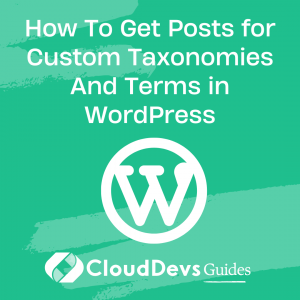How To Get Posts for Custom Taxonomies And Terms in WordPress
Table of Contents
WordPress is a popular content management system that allows users to create and manage content on their websites easily. One of the key features of WordPress is the ability to create custom taxonomies and terms. Custom taxonomies and terms are a way to organize content on your website based on your specific needs.
However, getting posts for custom taxonomies and terms can be a bit tricky, especially if you are new to WordPress. In this article, we will discuss various methods and techniques for getting posts for custom taxonomies and terms in WordPress.
1. Understanding Custom Taxonomies and Terms in WordPress:
Before we dive into the methods and techniques for getting posts for custom taxonomies and terms in WordPress, let’s first understand what custom taxonomies and terms are. In WordPress, a taxonomy is a way to group content together. WordPress comes with built-in taxonomies like categories and tags. Custom taxonomies are similar to built-in taxonomies, but they allow you to create your own custom groups for your content. Custom terms, on the other hand, are the individual items that belong to a taxonomy. For example, if you have a custom taxonomy called “Topics,” the individual terms within that taxonomy might be “Technology,” “Politics,” “Sports,” and so on.
2. Methods for Getting Posts for Custom Taxonomies and Terms in WordPress:
There are several methods for getting posts for custom taxonomies and terms in WordPress. The primary method is to use the WP_Query function, which is a powerful tool for retrieving posts from your database. WP_Query allows you to specify a wide range of parameters to retrieve posts based on your specific needs.
Another method for getting posts for custom taxonomies and terms is to use the get_posts function. This function is similar to WP_Query, but it is a simpler method that is easier to use for beginners.
3. Using the Taxonomy Parameters in WP_Query to Get Posts for Custom Taxonomies and Terms:
WP_Query is a powerful tool that allows you to retrieve posts based on a wide range of parameters. To retrieve posts for a specific custom taxonomy and term, you can use the taxonomy and term parameters. For example, to retrieve posts for the “Technology” term within the “Topics” custom taxonomy, you would use the following code:
$args = array(
'post_type' => 'post',
'tax_query' => array(
array(
'taxonomy' => 'topics',
'field' => 'slug',
'terms' => 'technology',
),
),
);
$query = new WP_Query( $args );
This code will retrieve all posts that are associated with the “Technology” term within the “Topics” custom taxonomy.
Advanced Techniques for Getting Posts for Custom Taxonomies and Terms in WordPress: There are several advanced techniques that you can use to get posts for custom taxonomies and terms in WordPress. One technique is to use meta_query to filter posts based on metadata associated with custom taxonomies. Metadata is information that is associated with a post that is not part of the post content. For example, if you have a custom taxonomy called “Authors,” you might store additional metadata for each author, such as their email address or bio. You can use the meta_query parameter in WP_Query to retrieve posts based on this metadata.
Another advanced technique is to use custom SQL queries to retrieve posts for specific custom taxonomies and terms. This technique requires more advanced knowledge of SQL, but it can be very powerful for retrieving complex sets of data.
4. Best Practices for Getting Posts for Custom Taxonomies and Terms in WordPress:
When getting posts for custom taxonomies and terms in WordPress, there are several best practices that you should follow. One important best practice is to avoid overusing custom taxonomies and terms. It’s important to only create custom taxonomies and terms if they are necessary for organizing your content. Overuse of custom taxonomies and terms can make it difficult for users to find the content they are looking for, and it can also make it more challenging to manage your content in the long run.
Another best practice is to organize your custom taxonomies and terms in a logical manner. This means choosing names that accurately describe the content that they represent, and using a consistent naming convention throughout your website. For example, if you have a custom taxonomy for different types of products, it’s important to use consistent names for each term, such as “Electronics,” “Clothing,” and “Books.”
5. Conclusion:
Getting posts for custom taxonomies and terms in WordPress is an important aspect of organizing and managing your website’s content. By understanding the various methods and techniques for retrieving posts, you can create a more organized and efficient website that is easier for users to navigate. Whether you’re a beginner or an advanced user, there are many tools and resources available in WordPress to help you get the most out of custom taxonomies and terms. Remember to follow best practices and only use custom taxonomies and terms when necessary to ensure that your website remains organized and easy to use.


